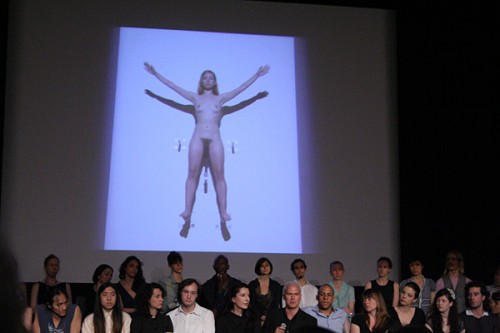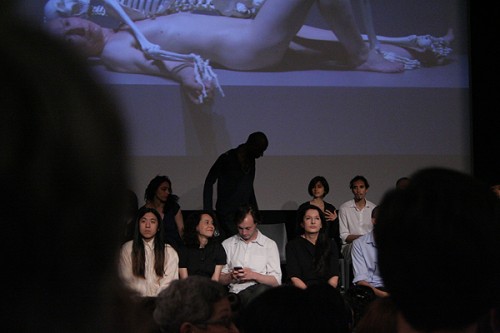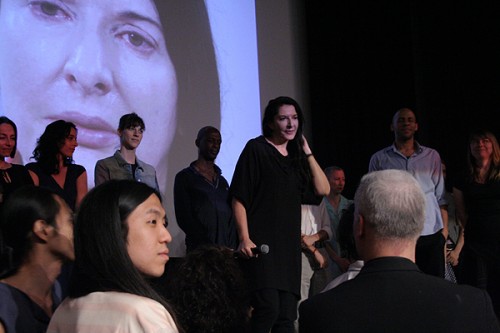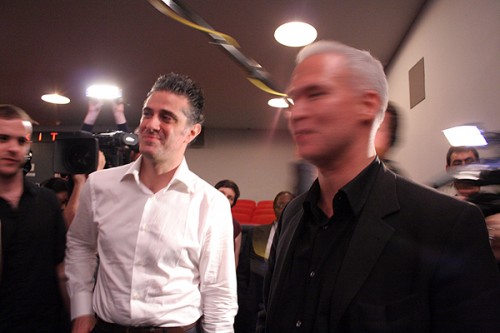POST BY MARINA GALPERINA
All photos by Marina Galperina
As Marina sat on her atrium throne on Monday, at 4pm the guards plowed lingering voyeurs out of the 6th floor gallery and her cast performers cried. Marina’s interviews played on a loop around the corner: “One thing I like about myself is my strong will.” At the post-The Artist is Present symposium on Wednesday night, the performance artist explained it all – the pain, the pee, the point – and showed that her “will” is not just mental and physical willpower required for her performances. It’s about control: If you’re going to do Marina, you better do it her way.
The artist revealed that the exhibit wasn't just a retrospective; it was a precedent for protecting the copyright of performance art works. “I was angry for fashion, I was angry for design, I was angry for MTV, I was angry for theater, for film, for mass media,” Marina boomed. She was angry for their plucking of images from the 70s, “changing the context” and the colors and using the unaccredited artist’s original idea to peddle products. To Marina, artistic homage requires a financial homage and an explicit agreement with the artist or his estate to use their intellectual property. She did this for the works of fellow performance artists she re-performed at the Guggenheim for Seven Easy Pieces. She had it done for herself at MoMA. That was her motivation for the retrospective.

36 re-performers — mostly dancers and artists – used their bodies as metaphors for Marina's poetry. “Trust” was essential but not accidental. All of Marina's re-performers went to her performance art boot camp. At the symposium, they emphasized “working for” the artist and “the gift” given to them with the permission to become Marina Abramović.

Why such control? Marina insists that her work is not sculptural. Imponderabilia is not two naked people standing in a doorway. They are metaphors for artists serving as doorways to a museum – because without artists, there is no museum. It's simple and effective. It's a physically manifested, interactive metaphor. Marina shared that a Canadian art center asked for permission to re-perform the work. If she had her way, she said she’d be sending her MoMA re-performers up to do it. After all, they are the ones she trusts not to make it a context-less show.

While Marina gushed with earnest gratefulness for “the love,” the repeat visitors (like Paco) and the time we sacrificed in wait, she recalled the throng tributary doppelgangers and copycats with amusement only.

There were several attempts to hijack focus during the exhibit. Marina didn't see the girl who took off her dress in front of her on Monday, only shadowy guards whisking someone away. Making nudity an unnecessarily big deal – “This is the problem in this country,” Marina said. She recalls how amidst the Iraq war, all the media was concerned with was that “Janet Joplin [Jackson] showed part of her tit” on television. To Marina, Americans fret over nudity too much. Yet, she called out her flasher as an attention monger. Somewhat earnestly, Marina insinuated that the flasher deliberately caused ruckus by disobeying museum rules. I'd like to think that the rebel artist would have said it differently, had she not been surrounded by museum staff.
Marina was displeased with the media's emphasis on nudity, mostly because it subverted the metaphorical nature of her work to sculptural spectacle. She thought the Tumblrs were funny though, and so were the “mystery pee” drawings that the Wall Street Journal erroneously credited to Jerry Saltz. She gushed over Marco Anelli fantastic portraits as well, the MoMA photographer who, for the duration of the project, shot Marina and her sitters. Klaus Biesenbach, MoMA's Chief Curator at large and the organizer of Abramović's exhibition was pleased to be merrily perched atop all this documentation. Biesenbach said he made it his objective to preserve the previously unpreservable, to collect and preserve performance art by recreating it and documenting the recreation. And there are plenty of artifacts now.

Klaus Biesenbach also felt he had to explain the concept of performance art to the audience. It is not “acting,” you see. The blood oozing from Marina's self-mutilated stomach in star formation is real. “In a movie, that would be ketchup.” The onions eaten by Marina in a cathartic jest were real onions. Actors don't eat real onions.” But, Klaus! Divine ate real dog shit in Pink Flamingos. There's even unsimulated sex (Antichrist, Pola X, etc) out there! There's a lot of artificial performance art out there. There's a lot of raw cinema too.

At a point during the symposium, Biesenbach tangentially asked Marina if the atrium performance MoMA commissioned is theirs now, as in, owned by the museum. Marina didn't give an explicit answer. But with all the concern about ownership, one thing is clear: Marina’s presence is essential to her work.
While the re-performers experiences were unarguably unique and affecting, these were internal experiences. Though filled with visible emotion, these were externally representational performances. They were tributes. Without ardently reciting her 40-year old body of work or describing the surreal experience of participating in The Artist is Present, there’s something to be said about Marina’s epic personality. There is something magnetic, strong and essential. She is inseparable from her work, or rather, her work is inseparable from her. Motivations or performance art can be explained philosophically, but they are always personal at the core. Once excavated from the source – Marina herself – they can only be echoed. You can perform, you can tribute, you can criticize – but you can never truly rob Marina Abramović.







Photos by Marina Galperina. She is a former Art Fag City intern and blogger for Animal New York.


{ 18 comments }
nice photos. these assistants have p/t jobs for life now, i bet… like with sol lewitt’s assistants. they will be supervising the performances after she has gone.
nice photos. these assistants have p/t jobs for life now, i bet… like with sol lewitt’s assistants. they will be supervising the performances after she has gone.
Abramovic’s ire against reappropriation, recontextualization, reuse, etc., are valid but rather conservative for such an avant garde artist. It also contradicts how dependant the show was on distributing such easily co-optable memes in venues that make such co-opting easy(i.e., Flickr). I don’t see much of a difference between what she’s criticizing and how she appropriated the Tibetan gold-eating ritual in her practice, which she later turned into a lipstick-stamped, mass-produced dessert at her celebration dinner (http://bit.ly/9aJyWF) — not to mention how this could be seen as a grabbing of Janine Antoni’s “Gnaw” (http://bit.ly/bCcDaE). If the exhibit was all about reinforcing the sovereignty of her presence, then why is Biesenbach’s creation, “documentation,” and “preservation” of “artifacts” considered any different than “peddling products?” Because Abramovic authorized it?
Protecting intellectual property is important (especially in regards to writing), but it’s a dicey issue and slippery-slope when you’re dealing with the arts. Abramovic wants to be treated as a brand. I like how this relates to the etymology of “corporation,” but it seems in direct conflict with all of her/the rhetoric that privileges the “presence” and contingency of (performance) art.
Abramovic’s ire against reappropriation, recontextualization, reuse, etc., are valid but rather conservative for such an avant garde artist. It also contradicts how dependant the show was on distributing such easily co-optable memes in venues that make such co-opting easy(i.e., Flickr). I don’t see much of a difference between what she’s criticizing and how she appropriated the Tibetan gold-eating ritual in her practice, which she later turned into a lipstick-stamped, mass-produced dessert at her celebration dinner (http://bit.ly/9aJyWF) — not to mention how this could be seen as a grabbing of Janine Antoni’s “Gnaw” (http://bit.ly/bCcDaE). If the exhibit was all about reinforcing the sovereignty of her presence, then why is Biesenbach’s creation, “documentation,” and “preservation” of “artifacts” considered any different than “peddling products?” Because Abramovic authorized it?
Protecting intellectual property is important (especially in regards to writing), but it’s a dicey issue and slippery-slope when you’re dealing with the arts. Abramovic wants to be treated as a brand. I like how this relates to the etymology of “corporation,” but it seems in direct conflict with all of her/the rhetoric that privileges the “presence” and contingency of (performance) art.
Or maybe she wants her performances to be treated as writing, like when playwrights, screenwriters, or songwriters require accreditation and payment for using their scripts.
Or maybe she wants her performances to be treated as writing, like when playwrights, screenwriters, or songwriters require accreditation and payment for using their scripts.
funny, I thought about Lewitt, too. And how the work absolutely *could* be separated from her, or at least re-performed without her, and yet it’s still inextricably hers.
The one thing that stuck out for me was her description of the end of the piece, and getting applause for 60 minutes, “which is unheard of, not even for Callas.” Comparing oneself to Maria Callas seems pretty extraordinary psychologically, and culturally, if not straight-up fame-wise.
I sense a stone cold diva smackdown in the afterlife.
funny, I thought about Lewitt, too. And how the work absolutely *could* be separated from her, or at least re-performed without her, and yet it’s still inextricably hers.
The one thing that stuck out for me was her description of the end of the piece, and getting applause for 60 minutes, “which is unheard of, not even for Callas.” Comparing oneself to Maria Callas seems pretty extraordinary psychologically, and culturally, if not straight-up fame-wise.
I sense a stone cold diva smackdown in the afterlife.
Video of this symposium can be seen here http://bit.ly/bZJz7u
And yes: she’s talking specifically about protecting the rights of performance artists. Her frustration at “design,” “fashion,” “MTV,” etc., was due to her seeing the work of performance artists get recontextualized – without accreditation – in the 70’s. It’s not unreasonable or surprising for her to want performance art to be held in higher esteem, but it is interesting if the entire thrust of her retrospective was to further institutionalize performance art and set a precedent for how performance artist’s intellectual property could/should be maintained.
Video of this symposium can be seen here http://bit.ly/bZJz7u
And yes: she’s talking specifically about protecting the rights of performance artists. Her frustration at “design,” “fashion,” “MTV,” etc., was due to her seeing the work of performance artists get recontextualized – without accreditation – in the 70’s. It’s not unreasonable or surprising for her to want performance art to be held in higher esteem, but it is interesting if the entire thrust of her retrospective was to further institutionalize performance art and set a precedent for how performance artist’s intellectual property could/should be maintained.
I’m a little bothered by how this ended; the “timed” sittings added a meat-grindery assembly line feeling that conflicted with the, uh, sublime experience some people seemed to have, and along with the VIP lists (which I don’t think were Abramović’s idea, but she consented) added a cynicism to the work that’s not really worse than the cultural re-appropriation that she criticizes, especially because that happens everywhere all the time. It’s essential to Abramović’s work that it not become a stunt, or else she becomes David Blaine with a political edge. And to greg,org: I dunno about Callas’ applause, but the first performance of Götterdämmerung got someting like a 1hr 45min ovation; I guess people feel that the duration of the applause should mimic the duration of the work?
I’m a little bothered by how this ended; the “timed” sittings added a meat-grindery assembly line feeling that conflicted with the, uh, sublime experience some people seemed to have, and along with the VIP lists (which I don’t think were Abramović’s idea, but she consented) added a cynicism to the work that’s not really worse than the cultural re-appropriation that she criticizes, especially because that happens everywhere all the time. It’s essential to Abramović’s work that it not become a stunt, or else she becomes David Blaine with a political edge. And to greg,org: I dunno about Callas’ applause, but the first performance of Götterdämmerung got someting like a 1hr 45min ovation; I guess people feel that the duration of the applause should mimic the duration of the work?
I am bummed that I have been out of NYC for so long and missed the end of this show and never sat with Marina.
I’ve been lucky to meet her on two occasions and she is a really incredible person with powerful energy and serious intelligence, and I think a lot of the bad press or bad vibes or whatever that she’s gotten throughout the exhibition is really misguided and uninformed. Not that everyone has to meet her before they can talk about her, but still.
I didn’t like the exhibition, it was too crowded with material, MoMA is the wrong museum for the show–it would have been much better in a much larger, less tourist-trap space, felt like it was toeing the line between aesthetic and historic without picking a side, and the recontextualizations of the performances felt really tepid and disappointing. But it was impossible to do the show without them, probably, and they were as good as they could have been, I think.
I do think, however, that the atrium piece was incredible, and I think that part of its power is the amount of vitriol it inspired. The fact that someone made themselves vomit on the last day of the show is really amazing to me. It’s much better to be hated (and loved, of course) than be forgotten and I think Abramovic is keenly aware of this.
Abramovic is also keenly aware of performance art’s standing in the art world, which is not very high (which is why it wasn’t until now that the MoMA had a major exhibition on performance art, and is also why the exhibition was not very good–as far as I know, nobody has tried to do something on such a scale before), and I think this is part of why she’s emphasizing the importance of performance artists being compensated for their work.
I am bummed that I have been out of NYC for so long and missed the end of this show and never sat with Marina.
I’ve been lucky to meet her on two occasions and she is a really incredible person with powerful energy and serious intelligence, and I think a lot of the bad press or bad vibes or whatever that she’s gotten throughout the exhibition is really misguided and uninformed. Not that everyone has to meet her before they can talk about her, but still.
I didn’t like the exhibition, it was too crowded with material, MoMA is the wrong museum for the show–it would have been much better in a much larger, less tourist-trap space, felt like it was toeing the line between aesthetic and historic without picking a side, and the recontextualizations of the performances felt really tepid and disappointing. But it was impossible to do the show without them, probably, and they were as good as they could have been, I think.
I do think, however, that the atrium piece was incredible, and I think that part of its power is the amount of vitriol it inspired. The fact that someone made themselves vomit on the last day of the show is really amazing to me. It’s much better to be hated (and loved, of course) than be forgotten and I think Abramovic is keenly aware of this.
Abramovic is also keenly aware of performance art’s standing in the art world, which is not very high (which is why it wasn’t until now that the MoMA had a major exhibition on performance art, and is also why the exhibition was not very good–as far as I know, nobody has tried to do something on such a scale before), and I think this is part of why she’s emphasizing the importance of performance artists being compensated for their work.
It sounds like a Hollywood ‘wrap’ party with press.
It sounds like a Hollywood ‘wrap’ party with press.
For the naysayers and cynics out there, I completely understand that initial impulse – it is what motivated me originally to observe for a while the developments in the atrium, think about it, read the press notes, and in particular the many vapid pieces like that of New York Times blogger Danto. I am actually humbly proud to see my views confirmed by Marina herself in that post event forum.
Now that the show is over, it is clear that Marina Abramovic has achieved two most important objectives and certainly took a good first stab at a third one:
1- she brought back to attention the history of performing artists, with the re-enacting of her past performances and exhibits
2- she provided a brilliant new piece whose future success was not so evident at its beginning -as the lukewarm cautious reviews made clear. Much will be digested and pontified about in the coming days, but her adaptibility and evolving choice of format worked wonders.
3- she brought up the possibility of creating a legacy for performance arts acts – as she mentions in her explanatory video on YouTube, although the artist will die the idea of his/her performance may survive him by re-enactments.
Some of the many touching testimonies from participants and other comments/ links are posted at http://www.flickr.com/photos/nycandre/4635624515/
For the naysayers and cynics out there, I completely understand that initial impulse – it is what motivated me originally to observe for a while the developments in the atrium, think about it, read the press notes, and in particular the many vapid pieces like that of New York Times blogger Danto. I am actually humbly proud to see my views confirmed by Marina herself in that post event forum.
Now that the show is over, it is clear that Marina Abramovic has achieved two most important objectives and certainly took a good first stab at a third one:
1- she brought back to attention the history of performing artists, with the re-enacting of her past performances and exhibits
2- she provided a brilliant new piece whose future success was not so evident at its beginning -as the lukewarm cautious reviews made clear. Much will be digested and pontified about in the coming days, but her adaptibility and evolving choice of format worked wonders.
3- she brought up the possibility of creating a legacy for performance arts acts – as she mentions in her explanatory video on YouTube, although the artist will die the idea of his/her performance may survive him by re-enactments.
Some of the many touching testimonies from participants and other comments/ links are posted at http://www.flickr.com/photos/nycandre/4635624515/
Comments on this entry are closed.
{ 1 trackback }